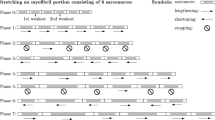Summary
In the series-fibred muscle architecture commonly found in large muscles of mammals and birds, the intrafasciculary-terminating muscle fibres have no direct tendinous attachments. Contractile force produced in these fibres must be transmitted between adjacent muscle fibres via the endomysial connective tissue which separates them. The endomysium is thus an essential mechanical component in such muscles. Studies of motor end-plate banding patterns and the frequent occurrence of tapering ends of fibres within the fascicles of the bovine sternomandibularis muscle show it to be a series-fibred muscle. Sodium hydroxide digestion of fixed samples of this muscle to remove the myofibrillar apparatus revealed the endomysium to be a disordered planar network of mainly curvilinear collagen fibrils.
The orientation distribution of the collagen fibrils in the endomysial network was measured by image analysis of scanning electron micrographs. Analysis of endomysial preparations from muscle fixed at sarcomere lengths between 1–4 μm showed that the orientation distribution of collagen fibrils is quantitatively related to muscle length. At rest sarcomere length the collagen fibril network is not completely random, but has a slight circumferential bias. The orientation distribution shows a progressive shift towards the circumferential direction at short sarcomere lengths and towards the longitudinal direction at long sarcomere lengths. The relationship between the number-weighted mean collagen orientation and sarcomere length was compared to two geometric models of network behaviour, the isoareal and constant shape models. both fitted the data reasonably, although the constant shape model described the rate of change of mean orientation more closely.
From fibrous composites theory, the reinforcement efficiency factor, η was calculated from the measured collagen fibril orientation distributions. These calculations predict a non-linearly increasing longitudinal tensile modulus for the endomysium with increasing sarcomere length, in agreement with its known non-linear properties, but confirm that the tensile properties of the endomysium are unsuitable for transmission of tensile force from muscle fibres contracting near rest length. This reinforces a previous interpretation that contractile force is transmitted between neighbouring muscle fibres by trans-laminar shear through the endomysium rather than by in-plane tension.
Similar content being viewed by others
References
BENNETT, H. S. & PORTER, K. R. (1953) An electrom microscope study of sectioned breast muscle of the domestic fowl. Am. J. Anat. 93, 61–105.
BORG, T. K. & CAULFIELD, J. B. (1980) Morphology of connective tissue in skeletal muscle. Tissue Cell 12, 197–207.
BORMIOLI, S. P. & SCHIAFFINO, S. (1977) Myomuscular junctions in reinnervated rat skeletal muscle. J. Anat. 124, 359–70.
COX, H. L. (1952) The elasticity and strength of paper and other fibrous materials. Br. J. Appl. Phys. 3, 72–9.
GUANT, A. S. & GANS, C. (1992) Serially arranged myofibers: an unappreciated variant in muscle architecture. Experientia 48, 864–8.
HULL, D. (1981) An introduction to composite materials. Cambridge: CUP.
KARNOVSKY, M. J. & ROOTS, L. (1964) A direct-colouring thiocholine method for cholinesterases. J. Histochem. Cytochem. 12, 219–21.
KRENCHEL, H. (1964) Fibre reinforcement. Copenhagen: Akademisk Forlag.
MAGID, A. & LAW, D. J. (1985) Myofibrils bear most of the resting tension in frog skeletal muscle. Science 230, 1280–2.
MAURO, A. & ADAMS, W. R. (1961) The structure of the sarcolemma of the frog skeletal muscle fiber. J. Biophys. Biochem. Cytol. 10, 177–85.
NATORI, R. (1954) The role of myofibrils, sarcoplasma and sarcolemma in muscle contraction. Jikeikai Med. J. 1, 18–28.
PODOLSKY, R. J. (1964) The maximum sarcomere length for contraction of isolated myofibrils. J. Physiol. 170, 110–23.
PURSLOW, P. P. (1989) Strain-induced reorientation of an intramuscular connective tissue network: implications for passive muscle elasticity. J. Biomechanics 22, 21–31.
PURSLOW, P. & DUANCE, V. C. (1991) Structure and function of intramuscular connective tissue. In Connective Tissue Matrix, Vol. 2 (edited by HUKINS, D. W. L.) pp 127–66. London: MacMillan Press.
ROWE, R. W. D. (1981) Morphology of perimysial and endo-mysial connective tissue in skeletal muscle. Tissue Cell 13, 681–90.
STREET, S. F. (1983) Lateral transmission of tension in frog myofibers: a myofibrillar network and transverse cytoskeletal connections are posible transmitters. J. Cell Physiol. 114, 346–64.
SWATLAND, H. J. (1975) Morphology and development of endomysial connective tissue in porcine and bovine muscle. J. Anim. Sci. 41, 78–86.
TORIGOE, K. & NAKAMURA, T. (1987) Fine structure of myo-myous junctions in the mouse skeletal muscles. Tissue Cell 19, 243–50.
TROTTER, J. A. (1991) The dynamic shape of tapered skeletal muscle fibers. J. Morphol. 207, 211–23.
TROTTER, J. A. (1993) Functional morphology of force transmission in skeletal muscle. Acta Anat. 146, 205–22.
Trotter, J. A. & Pursilow, P. P. Functional morphology of the endomysium in series-fibred muscles. J. Morphol. 212, 109–22.
Author information
Authors and Affiliations
Rights and permissions
About this article
Cite this article
Purslow, P.P., Trotter, J.A. The morphology and mechanical properties of endomysium in series-fibred muscles: variations with muscle length. J Muscle Res Cell Motil 15, 299–308 (1994). https://doi.org/10.1007/BF00123482
Received:
Revised:
Accepted:
Issue Date:
DOI: https://doi.org/10.1007/BF00123482




